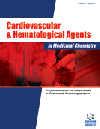- Home
- A-Z Publications
- Cardiovascular & Hematological Agents in Medicinal Chemistry (Formerly Current Medicinal Chemistry - Cardiovascular & Hematological Agents)
- Previous Issues
- Volume 18, Issue 2, 2020
Cardiovascular & Hematological Agents in Medicinal Chemistry (Formerly Current Medicinal Chemistry - Cardiovascular & Hematological Agents) - Volume 18, Issue 2, 2020
Volume 18, Issue 2, 2020
-
-
A Review on Impact of Medicinal Plants on the Treatment of Oral and Dental Diseases
More LessAuthors: Balakrishnan Arumugam, Arunambiga Subramaniam and Praveena AlagarajPlants play a vital role in the general wellbeing of an individual. Globally plants are habitually used by the people for the treatment and prevention of various ailments. There is an increased attempt made from ancient days to prevent the disease occurrence rather than to treat it. Through the development of modern scientific procedures, it is now identified that the usage of plants in different forms promotes the health of the p Read More
-
-
-
Stevia as a Natural Sweetener: A Review
More LessAuthors: Balakrishnan Arumugam, Arunambiga Subramaniam and Praveena AlagarajStevia rebaudiana of the Asteraceae family is a perennial shrub. It is a sweetener herb also known as sweet weed, sweet leaf, sweet herbs and honey leaf, native to Argentina, Brazil and Paraguay. The leaves of stevia are sweeter than sucrose with zero calories. Steviol, a diterpenoid glycoside derivative identified from this plant, is sweeter than sucrose and is safe when used as a sweetening agent. Diabetic and obese Read More
-
-
-
Toddalia asiatica L. - A Rich Source of Phytoconstituents with Potential Pharmacological Actions, an Appropriate Plant for Recent Global Arena
More LessAuthors: Praveena Alagaraj and Suriyavathana MuthukrishnanToddalia asiatica L. is used for a long period against various chronic diseases. The main objective of the present review is to search the literature for the folklore uses, phytochemicals isolated and their pharmacological properties of Toddalia asiatica L. The individual plant parts possess many phytoconstituents with therapeutic actions. The root bark of the plant is antimalarial, antipyretic and carminative. Plant leaves and stem Read More
-
-
-
Evaluation of the Antioxidant and Antidiabetic Potential of the Poly Herbal Formulation: Identification of Bioactive Factors
More LessAuthors: V.V. S. Uddandrao, Parim Brahmanaidu and Saravanan GanapathyBackground and Objectives: The present investigation is intended to prepare a Poly Herbal Formulation (PHF) with Piper nigrum (fruits), Terminalia paniculata (bark) and Bauhinia purpurea (bark) and assess their antioxidant and glucose-lowering effects utilizing in vitro models. Methods: The individual plant methanolic extracts and PHF are exposed to phytochemical examination and to distinguish the bioactive factors by GC-M Read More
-
-
-
Bioactive Sterol Derivatives Isolated from the Pleurotus djamor var. Roseus Induced Apoptosis in Cancer Cell Lines
More LessObjective: The aim of the present study is to isolate and characterize the bioactive compounds from Pleurotus djamor against human breast cancer (MDA-MD-231) and mouse T cell lymphoma (EL4) cell lines. Materials and Methods: Sequential fractionization and column chromatography methods were involved in compound isolation. The structures of the isolated compound were determined by NMR, GC/MS, and X-ray crystallograp Read More
-
-
-
Patent Foramen Ovale, the Role of Antiplatelet Therapy Alone or Anticoagulant Therapy Alone Versus Device Closure for Cryptogenic Stroke: A Review of the Literature and Current Recommendations
More LessAuthors: Harsha S. Nagarajarao, Chandra P. Ojha, Archana Kedar and Debabrata MukherjeeCryptogenic stroke and its relation to the Patent Foramen Ovale (PFO) is a long-debated topic. Recent clinical trials have unequivocally established the relationship between cryptogenic strokes and paradoxical embolism across the PFO. This slit-like communication exists in everyone before birth, but most often closes shortly after birth. PFO may persist as a narrow channel of communication between the right and left atria in appr Read More
-
-
-
p-Cymene Modulate Oxidative Stress and Inflammation in Murine Macrophages: Potential Implication in Atherosclerosis
More LessAuthors: Tong Wu, Zahra Mazhar, Dhuha Alsayrafi and Mahdi GarelnabiBackground: p-Cymene (p-CYM) is a common chemical used in air fresheners. Objective: The study was designed to investigate the molecular effect of p-CYM on macrophages. Materials and Methods: Macrophages (RAW 264.7) were treated with p-CYM (50 uM/L, 150 uM/L and 250 uM/L) for 6 hours, and 24 hours). Gene involved in inflammation, such as the Tumor Necrosis Factor-alpha (TNF-α), and the Monocyte Chemoattra Read More
-
Volumes & issues
-
Volume 23 (2025)
-
Volume 22 (2024)
-
Volume 21 (2023)
-
Volume 20 (2022)
-
Volume 19 (2021)
-
Volume 18 (2020)
-
Volume 2 (2020)
-
Volume 17 (2019)
-
Volume 16 (2018)
-
Volume 15 (2017)
-
Volume 14 (2016)
-
Volume 13 (2015)
-
Volume 12 (2014)
-
Volume 11 (2013)
-
Volume 10 (2012)
-
Volume 9 (2011)
-
Volume 8 (2010)
-
Volume 7 (2009)
-
Volume 6 (2008)
-
Volume 5 (2007)
-
Volume 4 (2006)
Most Read This Month
Article
content/journals/chamc
Journal
10
5
false
en


